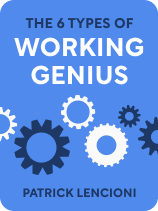

This article is an excerpt from the Shortform book guide to "The 6 Types of Working Genius" by Patrick Lencioni. Shortform has the world's best summaries and analyses of books you should be reading.
Like this article? Sign up for a free trial here.
What are the six different kinds of intelligence every team needs? How do these types of “genius” contribute to project development?
Patrick Lencioni’s The 6 Types of Working Genius argues that there are six distinct types of working intelligence and that all successful teams consist of members each possessing a combination of each type. By properly identifying which traits your team members have, you can maximize both productivity and individual fulfillment.
Keep reading for an in-depth look at each kind of intelligence.
The Six Geniuses
Lencioni explains that an intelligence type is intrinsic to the individual, meaning the types reflect what that person is naturally good at. Each intelligence helps people excel at one of six essential activities required during any project, from developing your next product to planning a family vacation to establishing a summer fundraiser for your local charity group. These are Lencioni’s names for the different kinds of intelligences as well as the descriptions we’ll use to reference them:
- Wonder: Perceiving Opportunity
- Invention: Innovating Solutions
- Discernment: Vetting Ideas
- Galvanizing: Mobilizing People
- Enablement: Supporting
- Tenacity: Seeing Things Through
We’ll describe each intelligence type in more detail below. For now, it’s important to understand that Lencioni argues that each individual excels in only two intelligence types, that the intelligences are mutually complementing, and that all intelligence types must be represented for a team to succeed.
| Fixed Vs. Growth Mentality? Some may argue that Lencioni’s insistence that everyone celebrate and stick to their natural geniuses—and thus leave all remaining tasks predominantly to others—fits into a fixed mindset approach, where you stick to what you know, believing what you’re good and not good at are essentially unchangeable. In Mindset, Carol Dweck argues that such a fixed mindset can limit you to believing you can never evolve to succeed at anything new. For example, a person who is self-observably good at literature may determine that they will never be good at science. According to Dweck, this can lead to insecurity and complacency. Alternatively, people with a growth mindset believe they can improve any skill through hard work, persistence, and the right learning strategies. |
Lencioni argues that each of these six intelligences has either a responsive (passive) or disruptive (active) quality and that this stems from the source of the intelligence’s inspiration. Passive intelligences draw inspiration from the surrounding world and formulate approaches to changing or reorganizing it—in other words, they respond or react to situations. Active intelligences rely instead on their own internal powers to instigate change or impact behaviors—they create, innovate, and pull ideas from thin air.
(Shortform note: Managers can benefit from considering passive vs. active personalities in determining how they approach tasks including training, motivating, and giving feedback. For example, passive employees may require more prompting to share opinions, whereas active personalities thrive in free-form, open conversations. Additionally, passive employees typically avoid conflict, making a lighter, supportive work environment more conducive to their success. On the other hand, active personalities embrace conflict, making it important to provide them with venting opportunities while also tempering tendencies to dominate discussions or offer excessive pushback.)
Moreover, each intelligence is defined by its role during one of three stages of work that Lencioni defines: ideation, activation, and implementation. From here on out, we’ll refer to these as the brainstorming, set-up, and follow-through phases, respectively, and we’ll describe them in more detail below. Each of these three phases comprises two intelligences—one passive and one active.
Lencioni illustrates the three phases on a downwardly sloping gradient he calls elevation. The earliest phase of work (brainstorming) is at the top, descending through the remaining phases toward the project’s completion. This gradient has a metaphorical quality, where the earliest phases of work occur when our heads are in the clouds and activities are most conceptual. The process then eventually gains practical definition as it descends.
Lencioni emphasizes that one phase of work or intelligence is not better than another—only that they are most effective in a specific sequence in the life cycle of a project. For instance, early-stage discussions typically can’t tolerate too much task-mastering, because they’re meant to be more open and imaginative. Similarly, abstract creativity in later-stage discussions can distract the focus from the project’s execution and last-minute problem-solving. This means that putting team members in positions that don’t capitalize on their unique intelligence can derail the project.
Intelligence #1: Perceiving Opportunity
Category: Passive
The person with this intelligence gets the ball rolling. She recognizes an opportunity in the status quo and contemplates what’s possible. This intelligence is passive because it reacts to external challenges calling out for solutions and is required to catalyze projects.
For example, imagine your company wants to develop a new razor blade for personal care, but that particular market is saturated. This person sees where your competitors are going wrong and why their products don’t fully satisfy consumer demands: because their prices are staggeringly high. Instead of seeing difficulty, the person with this intelligence sees an opportunity—if you could lower production costs while maintaining quality, your company could make its mark.
(Shortform note: Based on Lencioni’s description, people with the Perceiving Opportunity intelligence might be particularly good at letting their minds wander. Psychologists say that see-sawing between daydreaming and task-focused thinking throughout the day bolsters creativity. The daydreaming interval allows you to break away from time-bound concerns and escape into imagination. Then, when your thoughts return to the task in front of you, you see reality through a new lens.)
Intelligence #2: Innovating Solutions
Category: Active
The teammate with this intelligence thinks outside the box. After the person with Perceiving Opportunity intelligence identifies the problem or opportunity, the person who innovates solutions provides an approach to fixing or seizing it through her industrious imagination. This intelligence type is active because it relies on its own inherent creativity and vision and is adept at leading brainstorming sessions with onslaughts of new ideas. The person with this type of intelligence is likely the one who will come up with an ingenious design solution for your new product, and because this intelligence is active. she’ll do so without the need for prompting or direction. Perhaps this person sees how to use a lower-cost but high-quality alloy for your company’s razor blade and that machining this alloy with precision will also take less time than the competitor’s expensive, conventional blade.
Intelligence #3: Vetting Ideas
Category: Passive
The person with this intelligence is the one who determines if the proposals suggested during the brainstorming stage meet the criteria of reality. In other words, are they achievable? This person might be the one to question the feasibility of producing your new item on a competitive scale or warn about how much time and money will go into its development.
This intelligence is passive because it requires the existence of ideas outside itself to evaluate; yet, this person is vital in helping organizations select ambitious yet realistic projects. These are the people in your organization who you constantly look to for their intuition and honesty. The person with this intelligence might point out that supplies of your new alloy are not always reliable, making long-term use an issue, or that engineers have already tried and failed to use it. She may suggest that the company find its own supply source and specific engineering talent to make that avenue safe.
Intelligence #4: Mobilizing People
Category: Active
The teammate with this intelligence encourages teammates to buy in to projects and is indispensable to getting almost any process off the ground. The intelligence is active because it generates energy and enthusiasm and then passes them along to others. This teammate will get everyone oaring in the same direction and to the same tempo, ensuring that effort is concerted and morale is strong. She will relay to your entire staff how revolutionary your new razor design is (how your organization is the first to use that alloy, in particular) and that the price point you’re going to offer will change the entire market.
These attributes make this intelligence of motivating critical to the central phase of work; in essence, it is a cheerleader archetype.
Intelligence #5: Supporting
Category: Passive
The person with this intelligence notices when teammates require assistance and jumps in to help them. Lencioni says that this person often recognizes that their teammates need help before they realize it themselves, making them indispensable to the team during fever-pitched moments. For instance, this person might observe that machinists in your manufacturing department are having trouble applying the specs given to them by engineering and then obtain clarification for them. Or, they could help the marketing department express the benefits of your chosen alloy in laymen’s terms so investors and customers understand and become intrigued.
According to Lencioni, this intelligence is passive because it involves responding to others on the team who need assistance.
Intelligence #6: Seeing Things Through
Category: Active
The person with this intelligence is the taskmaster. She always keeps the end goal in mind, making sure efficiency, timing, and quality are on point. People with this intelligence love to check boxes—they are relentless, nuts-and-bolts thinkers. This is the person who makes sure your new razor blade is ready for that vital sales quarter, that everyone knows the quality and uniqueness of what they’re selling, and that the product itself delivers value, precision, quality, and durability. She’s often focused on late-stage problem-solving, making her territory the least conceptual and most pragmatic stage of work.
This intelligence is active because its personality provides the drive and focus required to see things through. The principal distinction Lencioni describes between this person and someone with Mobilizing intelligence—the person who energizes and motivates the team during the set-up phase of work—is that mobilizing is about inspiring teammates, whereas seeing things through is about doggedly pursuing the goal.

———End of Preview———
Like what you just read? Read the rest of the world's best book summary and analysis of Patrick Lencioni's "The 6 Types of Working Genius" at Shortform.
Here's what you'll find in our full The 6 Types of Working Genius summary:
- The six types of working intelligence that successful teams need
- How to identify which traits your team members have
- How to apply the six types of genius to bolster workflow and well-being






